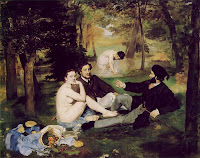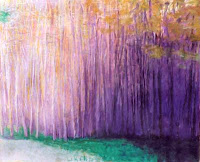Painting on the Edge (or Art vs. Craft) – An Opinion
For contemporary painting to be taken seriously by the “real art” world, it is expected to create some element of surprise, incongruity, or discomfort (if not shock), be a little off kilter or unsettling – what is sometimes referred to as being edgy.Although, like almost everyone, there is much current art that I don’t like, I find the idea appropriate. This is not a new idea – it has become a thoroughly engrained part of our culture’s painting tradition over the last 150 years, with roots going back 500 years.
Painting, once one of the skilled crafts, was nudged from its utilitarian moorings as a conveyor of information and narrative by (among other influences) the twin forces of Luther and Gutenberg – the former giving rise to the idea of the importance of the individual (and individual creativity) and the latter conveying information by more efficient means. 

At first, the evolution of painting
from craft to what we now call art was slow, but by the time photography came along, some painters (most of the ones deemed important today) were staking out non-traditional territory for themselves in some pretty edgy places: Manet with his roughly executed “Picnic on the Grass,” showing two well dressed gentlemen with disrobed women in the woods; shortly afterwards, the Impressionists with their dabs of paint depicting ordinary subjects (profoundly shocking at the time); followed by the Fauves (“wild beasts”), the Cubists and so on through the Pop Artists and the Minimalists, et al.
Edginess now marks one of the boundaries between art and craft. The arts are full of surprises and tension, the crafts are comfortable and predictable – the arts challenge convention while the crafts are guardians of the comfortable past (a valuable and valid role – just not art).
Turner found some of his edginess in technique, Manet in social values, the Impressionists in subject matter, the Fauves in color, the Cubists in form, and Pop in the everyday. Some edges are rediscovered and reinterpreted –  today, just painting plein air is so reactionary that it can have some pretty edgy connotations.
today, just painting plein air is so reactionary that it can have some pretty edgy connotations.
 today, just painting plein air is so reactionary that it can have some pretty edgy connotations.
today, just painting plein air is so reactionary that it can have some pretty edgy connotations.Wolf Kahn and Fairfield Porter are modern plein air painters whose work is widely acknowledged in the broader art world. The edges that they staked out are now familiar. Ironically maybe the edgiest of images of the late 19th century were the tiny, abstract pochade box landcapes of James MacNeill Whistler. The renewed interest, after nearly a  century, in the small and intimate scale of many plein air paintings once again challenges convention.
century, in the small and intimate scale of many plein air paintings once again challenges convention.
 century, in the small and intimate scale of many plein air paintings once again challenges convention.
century, in the small and intimate scale of many plein air paintings once again challenges convention.For me, the risk of leaving behind comfortable tricks of the trade, familiar materials and pictorial formulas is that I’ll fail (frequently) or fall over the edge into shallow contrivance (sometimes). Pushing the envelope is frustrating, exasperating and uncomfortable, but when I’ve found a new edge and negotiated it more or less successfully, it sure beats just cranking out another pretty picture.
- Carl Judson




Sarah Judson
Author